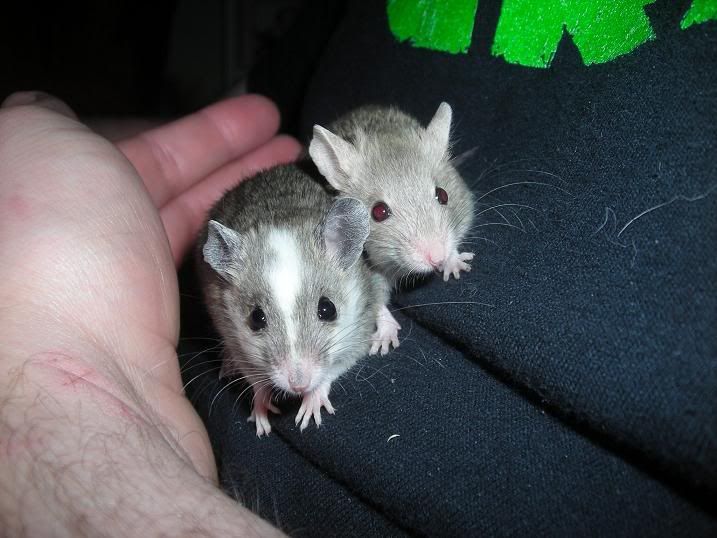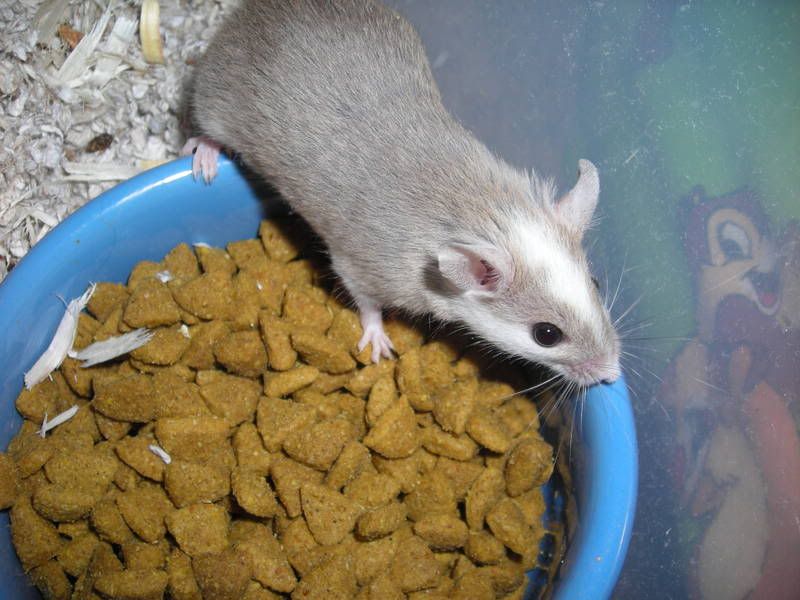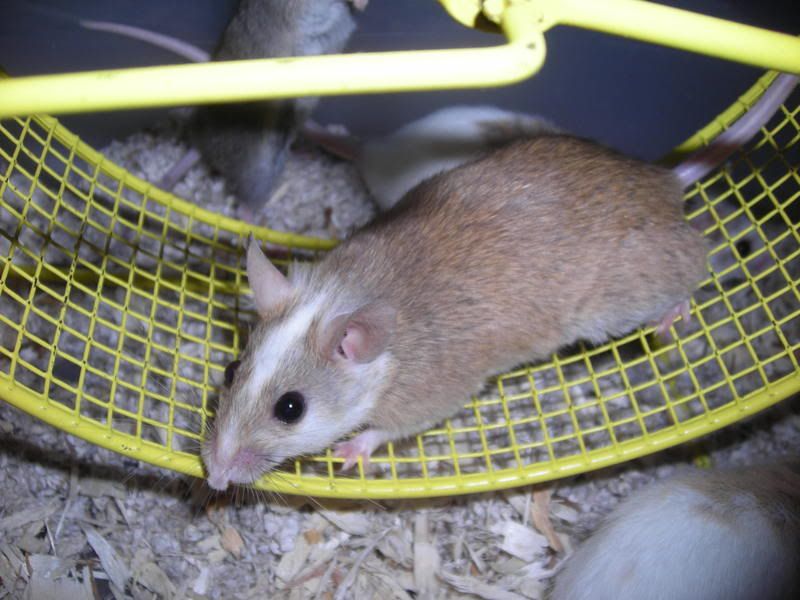| Home | Care Sheet | About Us/Breeding Goals | Planned and Upcoming Litters | Past Litters | Nursery/Available Natals | Breeders |
| Color, Marking, and Fur Types | Other Animals for Adoption | How to Adopt from TRT | Our Pets | Links | Shop the Web Store! |

Because of the natural habitat of where these animals originated, they prefer warmer temperatures. Do not let your Natal rats’ enclosure get below 60 degrees Fahrenheit for extended periods of time. Their ideal temperatures range from 72 to 86 degrees Fahrenheit.
Housing
The enclosure, or cage, you choose for your pet Natal rats will be one of the most important decisions you make. This is where your Natals will spend the majority of their time, thus bigger is better. As a rule of thumb, each Natal rat should have at least 12” x 12” x 12” of living space. Natals should only live in groups of three or more, so keep this in mind when choosing a habitat.
There are many variations of housing one can use to house these rodents. There are glass aquariums, wire cages, and homemade cages.
The glass aquarium: The glass aquarium, or tank, can make a decent enclosure for Natal rats. A 20 gallon long should be plenty big enough for a trio of same-gender Natals. A 10 gallon, however, will not be sufficient for more than a pair. Tanks do have their pros and cons, as with any cage. The pros consist of unobstructive viewing of your pets, you can provide deep bedding for burrowing, and they are relatively cheap if purchased used. Make sure to have a well ventilated top (screen tops are best, or you can make your own out of wire mesh.) Unlike domestic rats, Natals have little issues with their respiratory tracks, and a glass aquarium can, when kept clean, be adequate. The cons of tanks are lack of creativity in giving them an enriched environment, and they can be bulky and hard to clean.
Wire cages: Wire cages would be my first choice. Mouse and hamster sized cages are generally too small for a trio. I suggest using all-metal (powder-coated,) multi-level small pet cages. The issues with these is the bar spacing on the walls of the cage. It must be at a maximum size of ˝” to prevent escapes. Baby Natals can usually squeeze through ˝” and I recommend keeping them in glass tanks until they’re big enough for wire cages. The wire allows unobstructed ventilation, lots of climbing room (they love to climb!) and large opportunities to provide hammocks and other hanging toys. The majority of these cages are easy to clean. Once a week, just take the cage and shower it off in your tub with soap and water.
 Homemade Cages: Homemade cages have very little limitations. You can make it as big, with as many levels, built-in dens and burrows, etc. as your imagination and wallet allows. The most popular homemade Natal rat cages are your general storage bin/sterilite cages. These are economical, effective, and easy to clean. Buy the biggest storage tub you can find/afford at almost any retail store. Also, buy a small roll of ˝” x ˝” wire mesh at your local hardware or feed store. Use a box cutter, and cut out the inside of the lid. Hot glue the properly sized wire mesh cut out over the hole and viola! Instant cage. The pros are ease of cleaning, cheap, and effectiveness. The cons are lack of choices in size and low visibility of your pets.
Homemade Cages: Homemade cages have very little limitations. You can make it as big, with as many levels, built-in dens and burrows, etc. as your imagination and wallet allows. The most popular homemade Natal rat cages are your general storage bin/sterilite cages. These are economical, effective, and easy to clean. Buy the biggest storage tub you can find/afford at almost any retail store. Also, buy a small roll of ˝” x ˝” wire mesh at your local hardware or feed store. Use a box cutter, and cut out the inside of the lid. Hot glue the properly sized wire mesh cut out over the hole and viola! Instant cage. The pros are ease of cleaning, cheap, and effectiveness. The cons are lack of choices in size and low visibility of your pets.
Other homemade options include using said tubs as a “base” to build your own cage using wire mesh. Try avoiding wood, as this will get peed on and chewed up.
Diet
 Your Natal rats’ diet is one of the utmost important aspects in their care. They are still considered wild animals, as they are not domesticated, and thus must
be fed with great care. Seed mixes, and other commercial rodent diets (even lab blocks,) are not necessarily recommended. While a formulated lab block for rodents (such as Harlan Teklad,) may cover the majority of a Natal’s vitamins a minerals, they are mostly comprised of soy and corn, which are fillers. Natal rats prefer higher protein content than domestic rats (14% to 18%) or mice (10% to 14%) Natals generally like a 22% protein up to a 33% in their food. I use and recommend a high quality, grain free, dog kibble as a staple (such as Taste of the Wild, Before Grain, or Holistic Select,) supplemented with parakeet seeds (without sunflower seeds,) and millet spray. As with most rodents, fresh foods in moderation can be fun, healthy treats. A Natal rat’s favorite treats, however, are mealworms, wax worms, and millet spray.
Refrain from feeding your Natals high fat, high sugar foods. Avoid anything that is caffeinated, carbonated, and alcoholic. Never give your pets candy (including chocolate,) avocados, or fruit peels!
Your Natal rats’ diet is one of the utmost important aspects in their care. They are still considered wild animals, as they are not domesticated, and thus must
be fed with great care. Seed mixes, and other commercial rodent diets (even lab blocks,) are not necessarily recommended. While a formulated lab block for rodents (such as Harlan Teklad,) may cover the majority of a Natal’s vitamins a minerals, they are mostly comprised of soy and corn, which are fillers. Natal rats prefer higher protein content than domestic rats (14% to 18%) or mice (10% to 14%) Natals generally like a 22% protein up to a 33% in their food. I use and recommend a high quality, grain free, dog kibble as a staple (such as Taste of the Wild, Before Grain, or Holistic Select,) supplemented with parakeet seeds (without sunflower seeds,) and millet spray. As with most rodents, fresh foods in moderation can be fun, healthy treats. A Natal rat’s favorite treats, however, are mealworms, wax worms, and millet spray.
Refrain from feeding your Natals high fat, high sugar foods. Avoid anything that is caffeinated, carbonated, and alcoholic. Never give your pets candy (including chocolate,) avocados, or fruit peels!
Bedding and Litter
Stay away from pine and cedar! This is bad for ALL small pets! It can cause a variety of health issues, and just is not worth the risk! There is a wide selection of litters available. Aspen shavings are safe and effective, as well as relatively cheap. You can also use recycled paper product litters such as Yesterday’s News or CareFresh. Yesterday’s News consists of hard pellets of compacted recycled paper, which can be uncomfortable for your Natals to walk on all the time. CareFresh is pillow-soft, but can be dusty, causing your pets (and sometimes you,) to sneeze. All three of these litters can be purchased at any pet store or feed store.
One type of bedding that many rodent owners use is fleece material, either cut to fit the enclosure, or shredded into strips. These can be washed weekly and reused. It is also the most comfortable for the Natals, and you can be very creative with colors and patterns! Fleece can be purchased at all fabric stores and some other retail stores.
Cage Accessories and Toys
 You will need a food dish, water bottle, some form of bedding or litter, and a “hide” house for your pets as bare minimum. The hide house could be anything from cardboard boxes (replaced at least weekly,) or wooden or plastic houses purchased from pet stores. These are needed for your pets to feel comfortable and safe when they sleep, play, and cuddle with each other.
Exercise wheels are a requirement with Natal rats. These animals are very active, and need a place where they can vent most of their energy. Females need an absolute minimum of a 7 inch wheel, and males need a 10 inch wheel. I personally recommend using a 10 inch for both genders, just to give them that extra room. DO NOT use a wheel with spokes/bars to run on (even the plastic kind!) because these are easy for any rodent to break a leg, foot, or tail in. Always use wire mesh wheels or solid surface wheels, such as Comfort Wheels, Silent Wheels, Wodent Wheels, or the Super Pet wire mesh wheels.
You will need a food dish, water bottle, some form of bedding or litter, and a “hide” house for your pets as bare minimum. The hide house could be anything from cardboard boxes (replaced at least weekly,) or wooden or plastic houses purchased from pet stores. These are needed for your pets to feel comfortable and safe when they sleep, play, and cuddle with each other.
Exercise wheels are a requirement with Natal rats. These animals are very active, and need a place where they can vent most of their energy. Females need an absolute minimum of a 7 inch wheel, and males need a 10 inch wheel. I personally recommend using a 10 inch for both genders, just to give them that extra room. DO NOT use a wheel with spokes/bars to run on (even the plastic kind!) because these are easy for any rodent to break a leg, foot, or tail in. Always use wire mesh wheels or solid surface wheels, such as Comfort Wheels, Silent Wheels, Wodent Wheels, or the Super Pet wire mesh wheels.
Other toys include multiple card board boxes, toilet paper and paper towel tubes, hammocks (can be purchased at pet stores made for hamsters/rats/ferrets, or purchased only from people who make them to order,) and anything else you can imagine that is safe, clean, and creative!
Health and Illness
Unfortunately, not much is known about the common health ailments and their connection to genes in the Natal rat. Some have claimed to have mammary tumors in females and stomach tumors. As with any animal, as the first signs of illness seek veterinary care. Only a trained, reputable vet can diagnose and properly treat animals. Also, buying/adopting your pets from a reputable source may improve the quality of health in your Natal rats.